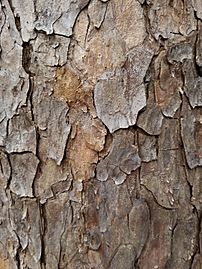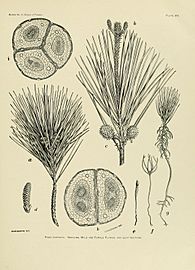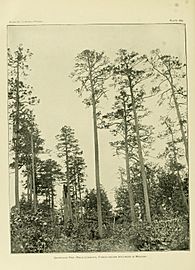Shortleaf pine facts for kids
Quick facts for kids Shortleaf pine |
|
|---|---|
 |
|
| Shortleaf pine savanna | |
| Conservation status | |
| Scientific classification | |
 |
|
| Natural range |
The shortleaf pine (also known as Pinus echinata) is a type of conifer tree. It has short needles and small cones. You can mostly find this tree in the southeastern United States. It grows well in many different climates.
People sometimes call other pines "shortleaf" by mistake. This is because in the Southeastern United States, people often just say "long-leaf" or "short-leaf" for all pines. But the true shortleaf pine (Pinus echinata) is special. You can tell it apart by its short leaves and small cones.
Contents
About the Shortleaf Pine
This tree can look different from one place to another. Some are straight, while others are a bit crooked. They usually have a crown (the top part with branches) that isn't perfectly even.
Size and Shape
Shortleaf pines can grow very tall, usually between 80 to 100 feet (24 to 30 meters). In good growing spots, they might even reach 100 to 120 feet (30 to 37 meters). Their trunks are quite wide, often about 1.5 to 3 feet (0.5 to 0.9 meters) across.
Leaves and Cones
The leaves are like needles. They grow in small bundles called fascicles. You'll find bundles with two or three needles mixed together. Each needle is about 7 to 11 centimeters (3 to 4.5 inches) long.
The cones are small, usually 4 to 7 centimeters (1.5 to 3 inches) long. They have thin scales with a small point. These cones open when they are ready but stay on the tree for a while.
Special Roots and Bark
Young shortleaf pine trees have a special J-shaped bend near the ground. If the top part of the tree gets damaged, new shoots can grow from this bend. This helps the tree survive fires.
The bark of the shortleaf pine has tiny spots called resin pockets. These are small dips, less than 1 millimeter wide. These pockets are a unique way to tell the shortleaf pine apart from other pines in its area. For example, a loblolly pine's bark looks different when young. But as both trees get older, the resin pockets on the shortleaf pine still help identify it.
The tree's crown (the top part with branches) is shaped like a pyramid. It has many small branches and keeps this shape for most of the tree's life.
Strong Roots
Shortleaf pines have very strong and deep roots. This helps them stand firm against strong winds. It also lets them find water deep underground, which means they can live in very dry places. Their long roots might be why they can grow in so many different climates.
Soil Preferences
You can find shortleaf pines growing in many types of soil. This includes stiff clay, gravel, and sand. While they are not picky about soil, they do not grow well in very wet or poorly drained areas.
How Shortleaf Pines Are Classified
The shortleaf pine belongs to the Pinus group of trees. Its scientific name, echinata, means "spiny" and comes from a word like "hedgehog." This refers to the small points on its cones.
This tree can naturally mix with another pine called Pinus taeda. The new tree that grows from this mix often looks more like the shortleaf pine. Philip Miller gave the shortleaf pine its name on April 16, 1768.
Where Shortleaf Pines Live
The shortleaf pine grows across the largest area of all the southern US yellow pines. You can find it from southern New York down to northern Florida. It also stretches west to eastern Texas and Oklahoma. These pines can live in many different places, from rocky uplands to wet flood plains.
Because they grow in such a large area, shortleaf pines can use many kinds of soil. Most of them grow in soils that don't have much organic material deep down but are still fairly moist. In the Southern Appalachians, shortleaf pines can grow at heights up to 3,000 feet (914 meters).
Shortleaf pines are part of 85 different forest types across 22 states in the U.S. However, the total number of shortleaf pines in the U.S. has gone down over time.
How Shortleaf Pines Interact with Nature
Shortleaf pines live in many different natural settings. These include hardwood forests and open woodlands. The type of soil, rocks, water, and how often fires happen all affect how these tree communities grow. They can grow in places with different amounts of water, like sand hills, sandstone hills, and slopes. They also live in rolling uplands and moist lowlands.
The Role of Fire
Fire is very important for shortleaf pines. It helps them grow, stay healthy, and regrow. Fires reduce other tree species that compete with the shortleaf pine. This helps more shortleaf pines survive. Fire also gets the soil ready for new trees to grow.
Shortleaf pines usually do well after controlled fires. If fires happen often, these trees can create a savanna environment. This is an open grassland with scattered trees. It has many different plants growing underneath and is a great home for the red-cockaded woodpecker.
Hybridization
The shortleaf pine often mixes naturally with loblolly pine and pitch pine where their growing areas meet. Mixing with loblolly pine has become more common recently. The new trees that result from this mix are less able to handle fire.
Uses of Shortleaf Pine
The wood from shortleaf pine is used for many things. It is used to make wood pulp (for paper), plywood veneer, and lumber. It's one of the "southern yellow pines" in the US. Sometimes, it's also called southern yellow pine or shortstraw pine.
Commercially, shortleaf pine wood is used for flooring and strong beams. In the past, it was used to build ship masts. During the Revolutionary War in the 1800s, it was a main source of wood for building homes.
Shortleaf pine is also known for its "lightwood," or "fat wood." This wood is full of resin and is great for starting fires. You only need a small match to light it.
Traditional Uses
The resin from the tree contains turpentine. In the past, this turpentine was used to help with kidney and bladder issues. It was also used as a rub or in steam baths for rheumatic infections. People also used it for breathing problems like the flu, coughs, colds, and TB. On the skin, it was used for burns, sores, wounds, and boils.
Protecting Shortleaf Pine
Since 1980, the number of shortleaf pines has dropped by 53%. This is because there haven't been enough natural disturbances, like fires, that the trees need to regrow. Farming and a lot of logging have also hurt them. Not having fires, changing land for other uses, and building new developments also harm shortleaf pines.
Shortleaf Pine Initiative
To help with this problem, the Shortleaf Pine Initiative (SPI) started in 2013. This group includes state and federal agencies, as well as public and private organizations. In 2016, they released a plan to help restore shortleaf pine forests. This plan focuses on bringing back woodlands that used to have many shortleaf pines. It helps people who manage natural resources, wildlife, and forests, as well as landowners.
According to NatureServe, the shortleaf pine (Pinus echinata) is in "critical danger" in New York, Pennsylvania, and Illinois. But it is "secure" (safe) in North Carolina and Virginia.
Shortleaf Pine Genetics
The shortleaf pine is a diploid organism, which means it has two sets of chromosomes. It has twelve pairs of chromosomes. Its genetic makeup is similar to other pine species. The amount of DNA in a shortleaf pine's chromosome is about 21.73 picograms.
The full genetic code of the shortleaf pine has not been mapped yet. However, scientists can use genetic information from the loblolly pine to study the shortleaf pine.
Genetic Improvement Program
In the 1960s, the United States Department of Agriculture (USDA) started a program. Its goal was to increase the genetic diversity of shortleaf pines. This is important for helping the species recover. They did this by breeding trees and testing their offspring.
However, this program had an unexpected effect. It made it easier for shortleaf pines to crossbreed with loblolly pines. Trees that grow fast are often desired, and hybrid trees (mixes of two species) tend to grow quickly. This made breeders choose these hybrid traits. Also, shortleaf pine tree farms are often next to loblolly pine farms, which can also lead to hybrid breeding.
See also
 In Spanish: Pino de hoja corta para niños
In Spanish: Pino de hoja corta para niños






